Keep your soap bars from sweating by maintaining temperatures between 60-75°F and controlling humidity levels. You'll want to store them in airtight containers with silica beads, wrap them in plastic after curing, and use cardboard boxes with rice grains for moisture absorption. Install fans for proper air circulation, and position soaps vertically on shelves away from heat sources. These foundational steps will open the door to mastering long-term soap preservation.
Optimal Storage Temperature Control
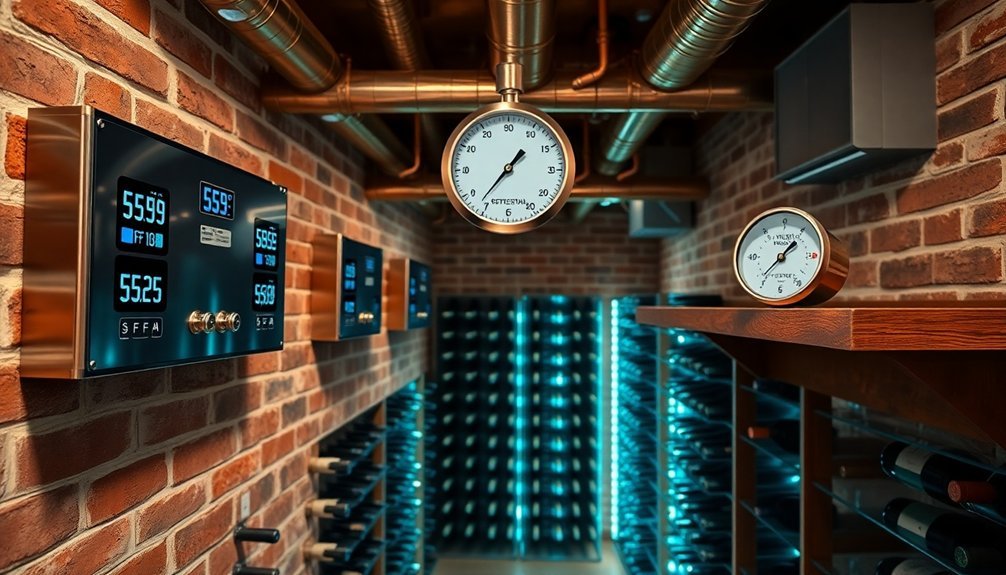
When storing homemade soaps, maintaining a temperature between 60°F to 75°F (15°C to 24°C) is essential to prevent moisture-related issues.
You'll want to choose a climate-controlled space, like a basement or dedicated storage room, to achieve this ideal storage temperature.
Don't place your soaps near heat sources or in direct sunlight, as these conditions can trigger unwanted sweating due to increased humidity.
Temperature fluctuations are your soap's enemy, causing condensation that leads to surface deterioration.
To stay on top of storage conditions, you'll benefit from installing temperature monitoring devices such as thermometers or hygrometers.
These tools help you track and adjust the environment as needed, ensuring your soaps remain in pristine condition.
Humidity Management Techniques
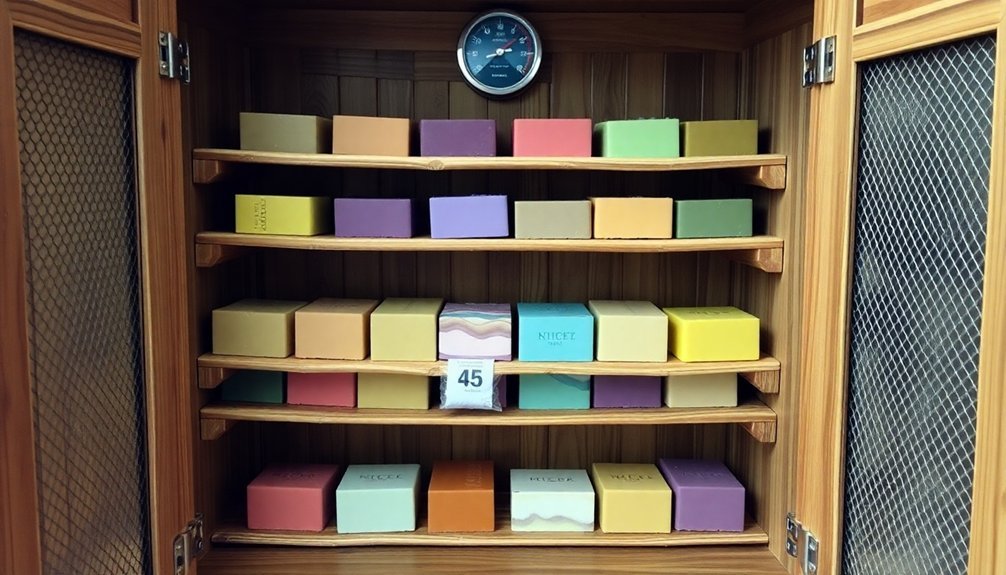
Since excessive moisture poses a significant threat to soap quality, implementing effective humidity management techniques is essential for preserving your handmade products.
When making soap, you'll want to create an environment that actively repels moisture. Set up an airtight container with silica beads, checking every 30 minutes to maintain ideal drying conditions.
Choose low glycerin soap bases like coco mango butter or shea goat milk melt & pour to minimize sweating risks.
After curing, immediately wrap your soaps in plastic or shrink wrap to prevent moisture attraction. Store them in cardboard boxes with rice grains as a natural moisture absorber.
For a thorough solution, install a dehumidifier or fan in your soap-making space to maintain lower humidity levels throughout production and storage.
Essential Air Circulation Methods
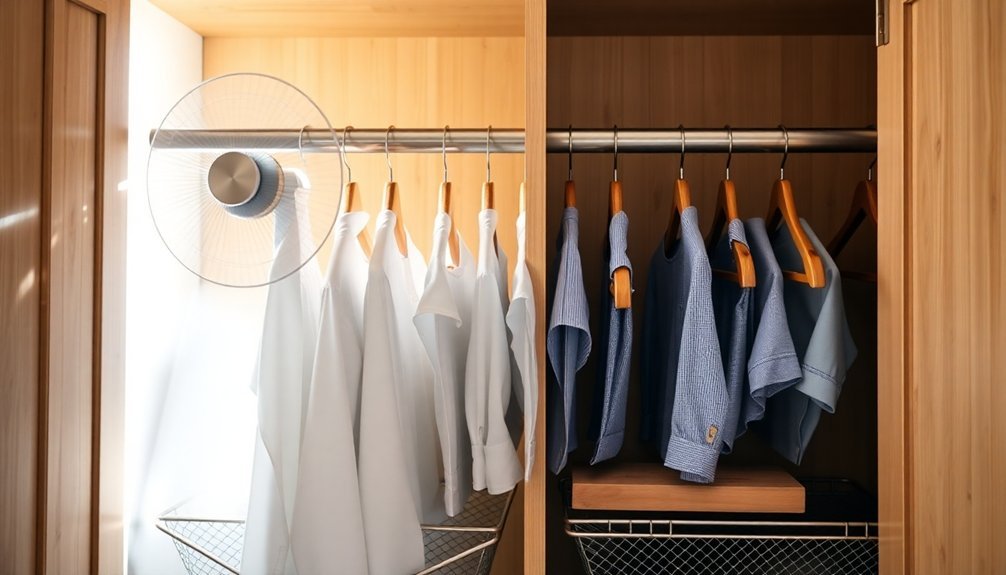
Proper air circulation works hand-in-hand with humidity control to protect your handmade soaps from moisture damage. You'll need a multi-layered approach to maintain ideal airflow in your soap storage area.
| Method | Benefit |
|---|---|
| Fan Installation | Creates consistent airflow throughout space |
| Airtight Room | Prevents external moisture infiltration |
| Regular Rotation | Guarantees even drying of soap bars |
Keep track of your storage environment's conditions using a hygrometer, and adjust your air circulation strategies accordingly. If you're in a particularly humid climate, consider investing in a dehumidifier as part of your air management system. Remember to position fans strategically to create a steady flow of air around your soaps, and maintain an airtight environment to enhance the effectiveness of your circulation methods.
Proper Packaging Materials Selection
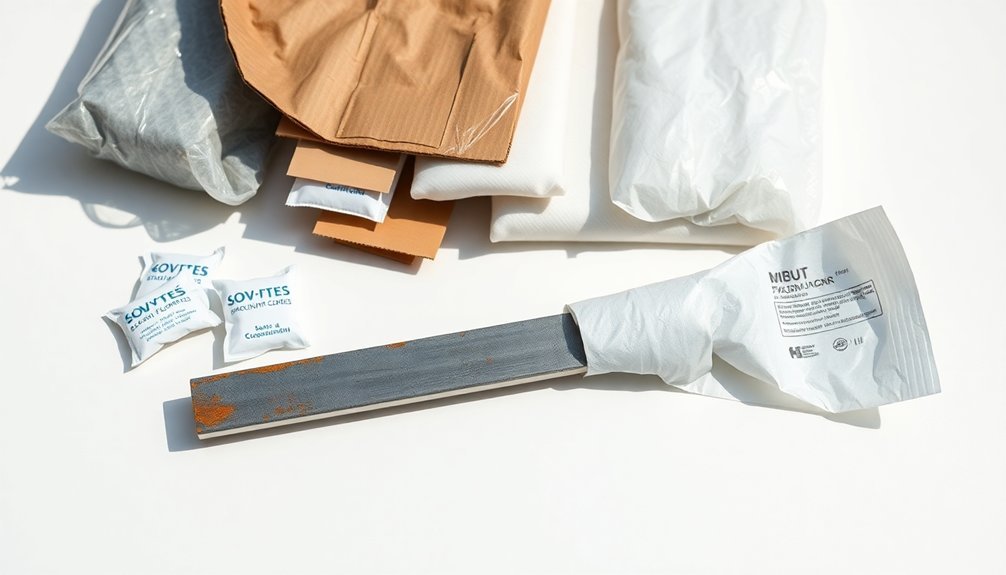
The art of selecting packaging materials can make or break your soap storage success. When you're soap making, choosing the right packaging prevents moisture absorption and keeps your bars fresh.
Start with shrink wrap or plastic wrap to create an immediate airtight seal after curing, then place your soaps in cardboard or paperboard boxes for an extra moisture barrier.
For proper packaging materials selection, here's what you'll need:
- Low-glycerin soap bases (like coco mango butter or shea goat milk melt & pour)
- Airtight containers with silica beads for moisture control
- Cardboard boxes or paperboard containers for long-term storage
Don't forget to monitor your storage containers regularly and replace them as needed.
If you're in a humid climate, add rice grains to your storage boxes for extra moisture absorption protection.
Moisture-Absorbing Solutions
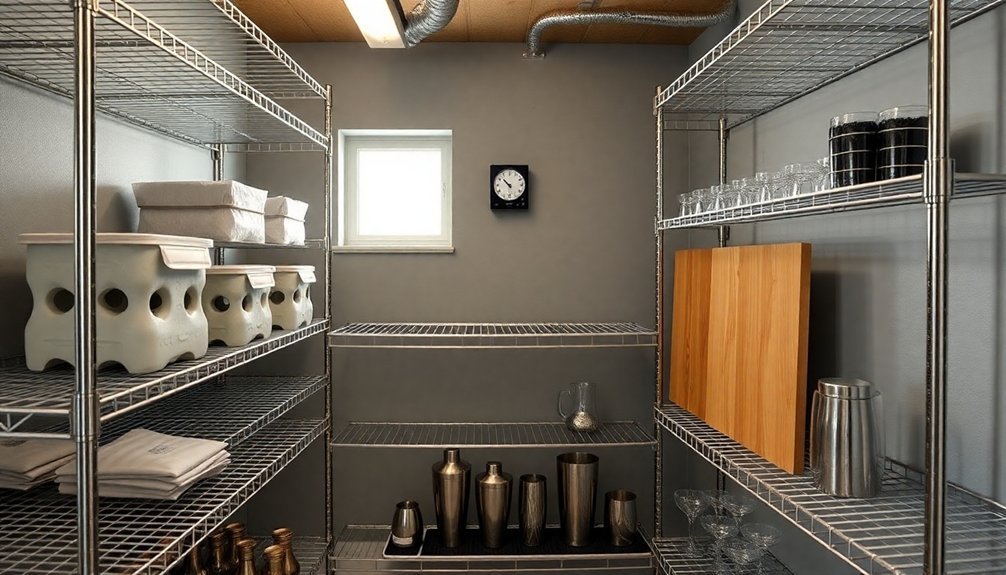
Managing moisture effectively stands at the heart of successful soap storage. You'll find several moisture-absorbing solutions that can keep your soaps fresh and prevent sweating.
Place silica gel beads in your airtight containers to trap excess moisture – they're highly effective and long-lasting. If you're looking for a budget-friendly alternative, rice grains work well too, though you'll need to replace them more frequently.
Store your soaps in cardboard or paperboard boxes, which naturally shield against ambient humidity. Don't forget to check and replace your moisture-absorbing materials regularly to maintain their effectiveness.
For larger storage areas, consider investing in a dehumidifier – it's an excellent way to control humidity levels and protect multiple soap bars simultaneously. These simple solutions will help preserve your soaps' quality and extend their shelf life.
Strategic Shelf Placement Tips
Choose a cool, dark corner of your storage area to minimize temperature fluctuations and protect your soaps from direct sunlight.
You'll want to place your soaps at mid-height level on shelves, as lower areas tend to collect more moisture and upper areas can trap warm air.
Keeping your soaps at eye level not only makes them easily accessible but also provides the most stable environment for preventing moisture-related issues.
Cool, Dark Corner Positioning
When storing handmade soaps, selecting an ideal corner location can make a significant difference in their preservation.
You'll want to position your soaps in a cool, dark corner that's shielded from direct sunlight and heat sources. This strategic placement helps maintain your soap's integrity and prevents unwanted sweating caused by temperature fluctuations.
Choose your storage corner with these specific features in mind:
- A spot that's at least 5 feet away from radiators, ovens, or heating vents
- A shelving area that's naturally shaded throughout the day, ideally in a pantry or closet corner
- A location with consistent temperature control, preferably in a climate-controlled room
Remember to monitor your chosen corner's conditions regularly and adjust the positioning if you notice any changes in your soap's appearance or texture.
Height Impacts Moisture Exposure
Because moisture naturally accumulates at lower levels, placing your handmade soaps on higher shelves can greatly reduce their exposure to humidity.
Height impacts moisture exposure considerably, as ground-level dampness can quickly affect soaps stored near the floor, especially in basements or laundry areas.
You'll want to arrange your soap bars vertically on elevated shelves with adequate spacing between them. This positioning maximizes air circulation and minimizes moisture contact.
If you're storing multiple bars, don't stack them horizontally – instead, stand them upright to allow proper airflow around each piece.
Choose storage locations that maintain consistent temperatures and lower humidity levels, such as climate-controlled rooms.
Container Selection Guidelines
Anyone storing handmade soaps knows that proper container selection can make or break their preservation efforts. When following container selection guidelines, you'll want to prioritize airtight containers made of glass or high-quality plastic to create an effective moisture barrier.
If you're on a budget, cardboard boxes can serve as a cost-effective alternative while still providing decent protection.
- Picture a row of crystal-clear glass jars, each perfectly sealed and showcasing your colorful soaps.
- Imagine sleek, BPA-free plastic containers with snap-tight lids, keeping your bars pristine.
- Visualize premium cardboard boxes lined with silica gel packets, working together to maintain the perfect environment.
Don't forget to inspect your containers regularly for moisture buildup and verify they're completely dry before use.
Replace any containers that show signs of wear to maintain ideal storage conditions.
Environmental Monitoring Systems
The right storage container means little without proper environmental control. That's where environmental monitoring systems come into play, offering you real-time tracking of humidity and temperature – two critical factors in preventing soap sweat.
You'll find these systems equipped with smart sensors that alert you when conditions exceed safe thresholds, letting you take immediate action before problems develop.
Better yet, many modern systems connect to your smartphone, so you can monitor your soap storage conditions from anywhere. By tracking environmental data over time, you'll spot patterns that help you choose the best times for production and storage.
Consider investing in a monitoring system to protect your soap. It's an effective way to maintain ideal storage conditions and guarantee your products stay in perfect condition longer.
Seasonal Storage Adaptations
You'll need distinct storage strategies for different seasons to maintain your soap's quality, with summer requiring extra attention to combat high humidity through dehumidifiers and airtight containers with silica beads.
During winter months, protect your soaps from extreme temperature fluctuations by keeping them in insulated storage areas away from cold drafts and direct heat sources.
Summer Humidity Control Methods
Summer humidity poses unique challenges for soap storage, requiring specific adaptations to protect your products from moisture damage.
You'll need to implement airtight solutions and moisture-control methods to prevent soap sweating during these warmer months.
Here's what you can do to maintain ideal storage conditions:
- Place silica beads or rice grains in your storage containers – they'll act as natural dehumidifiers, absorbing excess moisture that could affect your soaps.
- Invest in quality airtight containers or shrink-wrap your products to create a protective barrier against humid air.
- Set up a dehumidifier in your storage area and monitor humidity levels regularly.
Don't forget to check your storage materials periodically and replace them when needed.
These proactive steps will help preserve your soaps' quality and appearance throughout the summer season.
Winter Storage Protection Tips
While summer months demand specific humidity controls, winter brings its own set of storage challenges for soap preservation. To prevent excessive sweating during colder months, you'll need to monitor moisture levels carefully in your storage space.
Place your soaps in insulated containers and keep them in a cool, dry area away from heat sources that could cause temperature fluctuations.
Add silica gel packets to your storage containers – they're excellent at absorbing excess moisture from the air around your soaps.
Don't forget to check and rotate your stored soaps periodically to guarantee even air exposure throughout your collection. This rotation helps prevent moisture from accumulating in specific areas and maintains consistent conditions for all your bars.
With these protective measures, you'll keep your soaps in prime condition throughout the winter season.
Long-Term Preservation Methods
To guarantee your soaps remain in pristine condition over extended periods, implementing proper preservation methods is essential.
You'll find that high humidity poses a significant threat to your soap collection, but cardboard or paperboard boxes create an effective barrier against moisture. For ideal long-term preservation methods, line your storage containers with paper and add moisture-absorbing elements.
- Place silica beads or rice grains in your storage boxes to combat excess humidity.
- Store soaps in airtight containers, keeping them sealed from environmental fluctuations.
- Check your stored soaps regularly and replace storage boxes when they show signs of wear.
Monitor your soaps throughout seasonal changes, as varying humidity levels can impact their quality.
Frequently Asked Questions
How to Stop Sweating at Bars?
You can reduce sweating at bars by staying hydrated, wearing breathable clothes, using antiperspirant beforehand, finding spots near fans or AC, and taking occasional breaks outside to cool down naturally.
How Do I Stop My Pits From Sweating so Much?
You can control excessive pit sweating by using prescription antiperspirants with aluminum chloride before bed, wearing breathable fabrics, trying oral medications like glycopyrrolate, or considering Botox injections for longer-lasting relief.
Is There a Pressure Point to Stop Sweating?
Yes, you can try pressing the PC8 point in your palm's center and KD3 point on your inner ankle. These pressure points may help reduce sweating, though results vary from person to person.
What Can I Buy to Stop Excessive Sweating?
You can buy prescription-strength antiperspirants like Drysol or Hypercare, glycopyrronium medicated cloths, or an iontophoresis machine. For severe cases, you'll want to contemplate FDA-approved treatments like botulinum toxin injections.
In Summary
Keep your bar supplies in top condition by implementing these storage techniques consistently. You'll notice a significant reduction in sweating and moisture-related issues when you maintain proper temperature, humidity, and airflow. Don't forget to regularly check your monitoring systems and adjust seasonal storage as needed. With these proven methods, you're well-equipped to preserve your bar items and prevent costly damage from excess moisture.





Leave a Reply